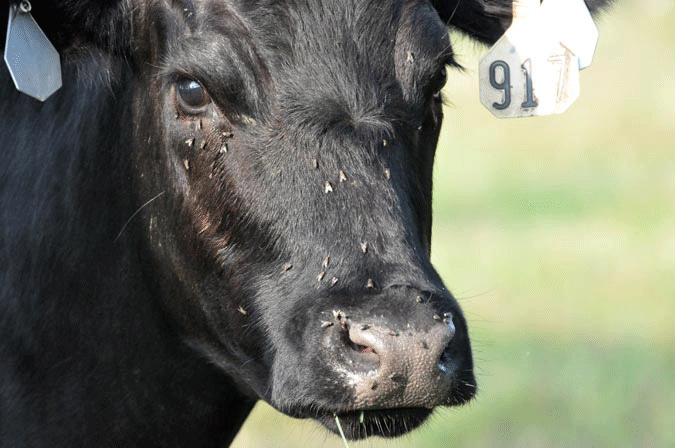June 11, 2014

Face flies are hard to control pasture pest. Their abrasive sponging mouthparts stimulate tears from livestock eyes. They can cause transmission of Moraxella bovis, or bovine pinkeye or infectious bovine keratoconjunctivitis. A good control program should keep face fly numbers below 10 per head.
Pinkeye varies greatly from year to year and usually is greatest during fly season, says Lee Townsend, University of Kentucky Extension entomologist in a June 10 blog post:
“English breeds with less pigment around the eyes (Hereford, Holstein Shorthorn) are more susceptible than are those with completely pigmented eyes (Angus). Infections are much worse in young animals than in old animals.
"Pinkeye is associated with shipping stress; increased sunlight; eye irritants such as tall, rough pasture grass; and other bacteria and viruses. The eye and nose discharges of infected animals can carry the pathogens, so direct animal-to-animal contact, contaminated equipment, and animal handlers can transmit the disease. Fly control is only part of the comprehensive program needed to reduce pinkeye incidence. Your veterinarian can help you to plan and implement a total program," he says.
Devices that allow animals to treat themselves and target the head and face area are most effective against face flies, he says.
“Even if a good pasture-fly control program is in place, these insects are strong fliers so they may move in from other herds, allowing fly numbers on animals to remain high.
Backrubbers with wicks or fly flips will allow cattle to treat themselves while loafing and scratching. The insecticide should be diluted with a good grade of mineral oil (diesel oil evaporates more quickly and is harder on the cattle’s skin) according to label instructions.
Dust bags are most effective when used where cattle have to pass under them daily to get to water or mineral feeders. Best coverage occurs when the animal must lift the bag with its head to pass through. Inspect the bag regularly and recharge it as needed. Keep it dry to reduce clumping of the insecticide and premature loss of effectiveness.
Feed additives or an insecticide bolus targets fly maggots breeding in fresh cow manure. Most are labeled for horn fly control only. All animals must eat a minimal dose of a feed additive regularly. Supplementary control measures must be used to deal with flies moving in from nearby herds.
Insecticide-impregnated cattle ear tags release small amounts of an insecticide, which are distributed over the animal during grooming or rubbing. Some pyrethroid tags can provide significant face fly reduction for several weeks," he says.
About the Author(s)
You May Also Like






